Tools of the Trade
by
Bob Brooke
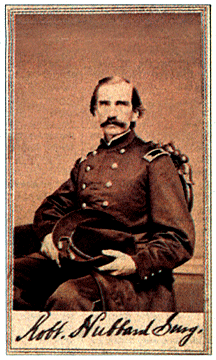 More men died on the
battlefield in the Civil War than in all previous American wars
combined. Part of the reason for these horrific casualty statistics is
that the Civil War was the first war fought by Americans in which guns
and cannon had rifled barrels which significantly increased the range at
which a soldier could accurately hit a target. Despite this, the Union
Army continued to send large forces of infantry against entrenched
opponents. More men died on the
battlefield in the Civil War than in all previous American wars
combined. Part of the reason for these horrific casualty statistics is
that the Civil War was the first war fought by Americans in which guns
and cannon had rifled barrels which significantly increased the range at
which a soldier could accurately hit a target. Despite this, the Union
Army continued to send large forces of infantry against entrenched
opponents.
When an entrenched opponent had smoothbore muskets, this tactic could
work because of their inaccuracy which allowed the advancing infantry a
good chance of reaching the enemy’s trenches, and then engaging in
hand-to-hand combat. But the pinpoint accuracy of the new rifled muskets
changed all that. These allowed the defending forces to thin the ranks
of the advancing infantry at a long range, killing and wounding many
before they could reach the entrenchments. The failure of both the Union
and Confederate commanders to realize this, combined with advances in
artillery, produced the horrific number of casualties during the Civil
War.
To make matters worse, medical knowledge in general and that of the
wartime surgeons was extremely low. For one thing, doctors didn’t
understand infection and did little to prevent it. Antiseptics had yet
to be used and doctors made no attempt to maintain sterility during
surgery. They didn’t have any antibiotics, so minor wounds could easily
become infected, and therefore fatal.
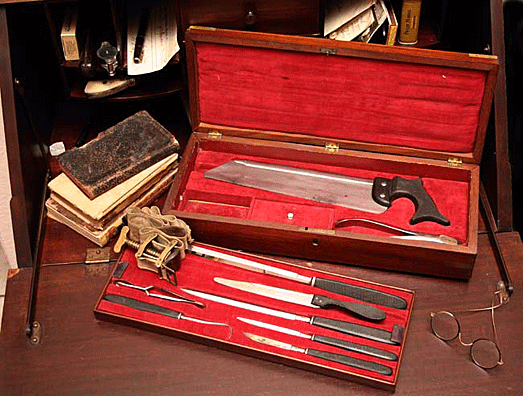
Any soldier fighting in the Civil War and injured was at the mercy of
poorly equipped surgeons. Surgeons generally let those with serious
injuries in the torso die. But those shot in the arm or leg, had only
one option—amputation.
The tide of wounded seemed never-ending to the overworked surgeons who
could afford to only spend a few minutes with each patient. For this
reason, many chose amputation as the treatment of choice and became
proficient at it. Often, they completed an amputation in ten minutes.
The shear volume produced stacks of amputated limbs up to five feet
high. Adding the lack of hygiene to this quick in and out work ethic,
it’s truly amazing that as many as 75 percent of the amputees did
recover.
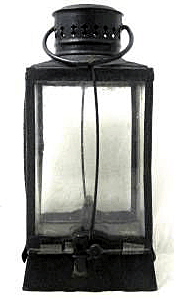 Today’s surgeons enjoy modern, sterilized operating rooms filled with
all sorts of high-tech, specialized equipment and bright, efficient
halogen lighting. The Civil War surgeon often had only a lantern, held
over the patient, for lighting. Farms, school houses, homes, and
churches became makeshift operating rooms while doors and kitchen tables
often acted as operating tables. Today’s surgeons enjoy modern, sterilized operating rooms filled with
all sorts of high-tech, specialized equipment and bright, efficient
halogen lighting. The Civil War surgeon often had only a lantern, held
over the patient, for lighting. Farms, school houses, homes, and
churches became makeshift operating rooms while doors and kitchen tables
often acted as operating tables.
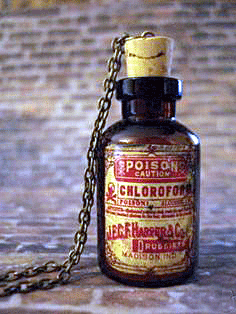 Much of the time they used chloroform, applied to a cloth and held over
the soldier's nose and mouth until the man was unconscious. But when
that wasn’t available, they made their patients drink whiskey to numb
the pain. There was a lack of water, basic supplies, drugs, and most of
all—time. The Battle of Gettysburg alone resulted in over 50,000
casualties in three days of savage fighting. No wonder many historians
call this battlefield surgery butchery. Much of the time they used chloroform, applied to a cloth and held over
the soldier's nose and mouth until the man was unconscious. But when
that wasn’t available, they made their patients drink whiskey to numb
the pain. There was a lack of water, basic supplies, drugs, and most of
all—time. The Battle of Gettysburg alone resulted in over 50,000
casualties in three days of savage fighting. No wonder many historians
call this battlefield surgery butchery.
Most Civil War surgeons did the best job they could under the
circumstances. And at least those in the Union Army worked with finely
wrought instruments, contracted for by the War Department. Basically,
the Union surgeon's kit consisted of two surgical saws, a curved probe,
retractor, cutting pliers, clamps, brush, and trepanning instruments
carried in a plush-lined wooden chest. Surgeons frequently practiced
trepanning with an instrument called a
trephine which drilled a circular hole into the skull to relieve
pressure on the brain tissue in the case of a compression fracture of
the skull or to remove a blood clot on the brain.
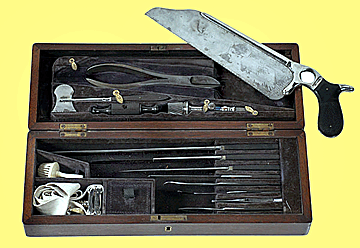 Confederate surgeons usually had to improvise. If they had a complete
surgery kit, made for that purpose, fine, but many of them didn’t. They
used common household tools instead, not bothering to clean or sterilize
them in any way. Pen knives became their scalpels, the bark of a tree, a
tourniquet, and the juice of the green persimmon, a styptic. They even
used common tableware to save a life in a pinch. Confederate surgeons usually had to improvise. If they had a complete
surgery kit, made for that purpose, fine, but many of them didn’t. They
used common household tools instead, not bothering to clean or sterilize
them in any way. Pen knives became their scalpels, the bark of a tree, a
tourniquet, and the juice of the green persimmon, a styptic. They even
used common tableware to save a life in a pinch.
Medical antiques, and in particular surgical or amputation sets, are
collectibles frequently associated with guns and war. As a result, it's
not unusual to find antique medical instruments on a table at a gum
show. Today, it’s easier to find surgical sets on sites like eBay.
However, collectors should do their homework before accepting any claims
that a particular Civil War surgeon used a set of instruments. Surgery
kits used by civilian surgeons at the time show little difference to
those used by the military. Unfortunately, much of what people claim to
be from the Civil War is of questionable provenance.
When trying to validate a surgical kit, the first thing to look at are
the types of handles on the cutting instruments. Prior to 1870, surgeons
usually just wiped the knife handle or saw blade on their apron to
remove the blood. Before and during the Civil War, cutting instruments
came with non-metallic handles made of ebonized wood, gutta percha (a
form of latex from a Malaysian tree), ivory, horn, or wood. After 1870,
with the widespread use of sterilization techniques, these porous
materials couldn’t stand up to chemical and heat treatments. So the
makers of surgical instruments began to use metal to make their
instrument handles.
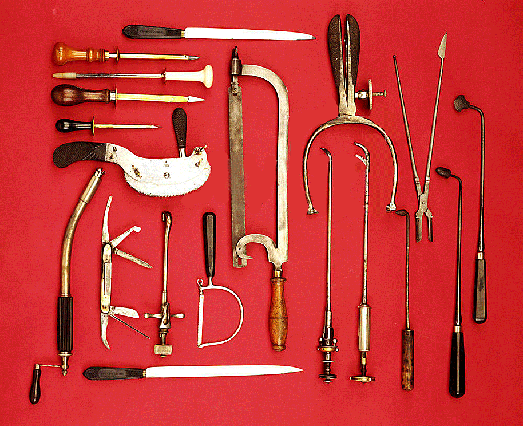
Civil War surgery sets, made or used during the war, came in three
types—U.S. Army Medical Department, U.S. Army Hospital Department, and
civilian. Military sets almost always had double sliding latches and no
keys while civilian sets had a central key and no latches.
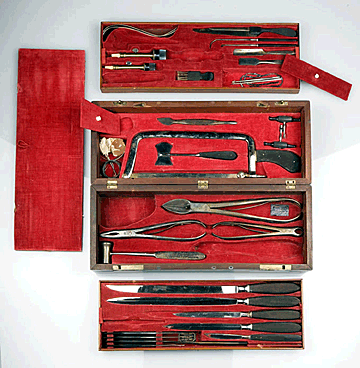 Military sets also had manufacturers marks. The major producers of these
surgical sets were in Philadelphia and New York, at least those
contracted by the Union Army. Dietrich W. Kolbe of Philadelphia, a maker
of deluxe surgery sets, and George Tiemann Co. of New York, the leader
in manufacturing high quality surgical instruments in the 19th century,
were two of the major producers. Brass plates on the top of the case and
engraving on the various instruments read U.S.A. Hosp. Dept., U.S.
Medical Department, or some variation. However, surgeons on either side
could have used any surgical set that existed in the United States prior
to or during the Civil War. Military sets also had manufacturers marks. The major producers of these
surgical sets were in Philadelphia and New York, at least those
contracted by the Union Army. Dietrich W. Kolbe of Philadelphia, a maker
of deluxe surgery sets, and George Tiemann Co. of New York, the leader
in manufacturing high quality surgical instruments in the 19th century,
were two of the major producers. Brass plates on the top of the case and
engraving on the various instruments read U.S.A. Hosp. Dept., U.S.
Medical Department, or some variation. However, surgeons on either side
could have used any surgical set that existed in the United States prior
to or during the Civil War.
The only authentic Civil War surgical instrument set is one marked and
designed for military issue. Sets used by the Confederacy came from
Northern American, English or European civilian makers. There are no
sets marked as being issued by the Confederacy since it purchased sets
wherever it could.
Values of surgical sets are largely determined by size—a larger set
commands a higher price than a smaller set—as well as condition, rarity,
completeness, provenance, and the desirability of the maker. Replacement
parts or parts that don't exactly fit the custom slots in a surgical kit
case will lower its value. Collectors should view a set with parts
marked by various makers as suspicious.
A multilevel major surgery set, including a bullet forceps, staves for
male urinary treatment, and extensive bone and amputation instruments,
today sells for $5,000 to $6,000 at auction.
To read
more of my articles, please
visit
my Web site.
< Back to Antiques Articles
Next Article > |
